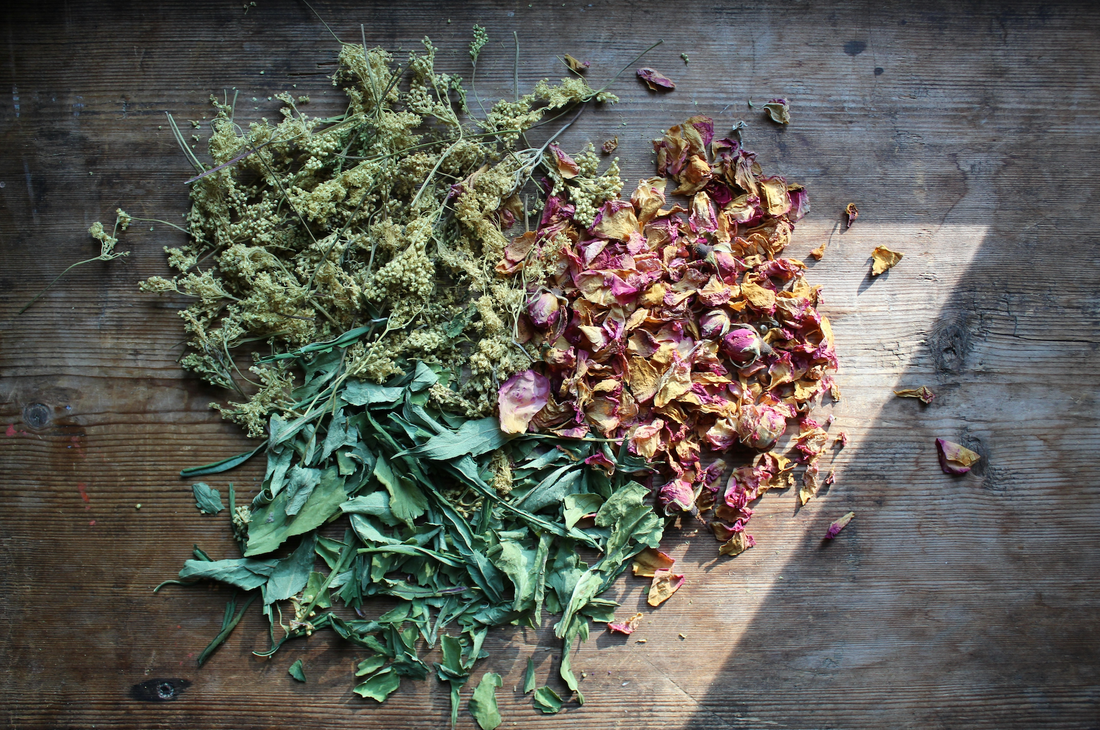
Big List of Smokable Herbs
Share
The Enchanting World of Smokable Herbs
Amidst the hustle and bustle of our daily lives, finding tranquility and a momentary escape can be a cherished respite. While smoking has primarily been associated with tobacco, the realm of smokable herbs offers a natural and often less harmful alternative. We made a list of smokable herbs to help you get started making your own herbal smoking blends.
Herbs You Can Smoke:
Calendula (Calendula officinalis): Calendula petals can be added to smoking blends for an attractive burst of color.
Catnip (Nepeta cataria): Catnip is primarily used in smoking blends as a relaxing herb and as a way to add flavor.
Chamomile (Matricaria recutita): Chamomile is a gentle and relaxing herb that can be added to smoking blends in small quantities. We suggest using only small amounts of chamomile, as larger quantities can produce a harsh smoke.
Coltsfoot Leaf (Tussilago farfara): Coltsfoot is an excellent base for adding other herbs. It produces a smooth smoke that can help soothe the lungs and reduce the harshness of other herbs.
Cornflowers (Centaurea cyanus): Similar to how calendula petals are used, cornflower petals are sometimes added to herbal smoking blends for their attractive purple-blue color.
Damiana Leaf (Turnera diffusa): Damiana is a well known mood booster and aphrodisiac herb.
Ginkgo Leaf (Ginkgo biloba): Ginkgo leaf provides a pleasant flavor when smoked. It may also benefit circulation.
Gotu Kola (Centella asiatica): Gotu kola can give smoking blends an earthy flavor. It provides relaxing benefits without causing tiredness.
Hibiscus Petals (Hibiscus sabdariffa): Hibiscus petals are less commonly smoked than many of the other herbs on this list, however, they are sometimes used as an ingredient in smoking blends to help provide a splash of color. Hibiscus petals do not have any appreciable benefits when smoked.
Holy Basil/Tulsi (Ocimum sp.): Holy basil is a flavorful smokable herb that can provide benefits for focus and anxiety.
Hops Flower (Humulus lupulus): Hops can be added to smoking blends in small quantities. It is especially beneficial as a smokable sleep aid.
Horehound (Marrubium vulgare): Horehound is an excellent base for herbal smoking blends. It is smooth and mild when smoked.
Hyssop (Hyssopus officinalis): Hyssop is a lung-loving member of the mint family. When used in smoking blends, it helps to support the lungs and throat.
Lavender Flower (Lavandula officinalis): Lavender is a flavorful smokable herb with smoke that tastes similar to how lavender smells. It is gently relaxing and flavor enhancing.
Lemon Balm (Melissa officinalis): Lemon balm can be added to smoking blends as a gentle soothing herb. It is mild in flavor and effect.
Lemongrass (Cymbopogon citratus): Lemongrass can produce a harsh smoke, so we suggest combining it with other more gentle herbs, such as mullein leaf. Lemongrass provides a pleasant flavor to herbal smoking blends and has an uplifting effect.
Licorice Root (Glycyrrhiza glabra): Licorice root can be added to herbal smoking blends to provide a sweet flavor to the smoke. Smoked alone, licorice root is quite harsh.
Linden (Tilia cordata): Linden can provide a gentle relaxing and anxiety relieving effect when used in herbal smoking blends.
Lobelia (Lobelia inflata): Lobelia can be smoked with caution. We suggest combining it with other herbs. Lobelia is non-addictive, and can activate the nicotine receptors in the brain, providing a satisfying alternative to tobacco. It is one of the most popular smoking cessation herbs available. Over consumption of lobelia can produce effects similar to the over consumption of nicotine.
Lotus Flower Blue (Nymphaea caerulea): Blue lotus, actually a member of the water lily family, is a popular smokable herb for enhancing dreams.
Lotus Flower Pink (Nelumbo nucifera): Pink lotus flower can produce relaxing and uplifting effects when smoked.
Lotus Flower Red (Nymphaea pubescens): Red lotus is a member of the water lily family that can be smoked. It produces relaxing and aphrodisiac effects.
Lotus Flower White (Nelumbo nucifera): White lotus flowers can be smoked for their calming and anxiety relieving effects.
Lungwort (Pulmonaria officinalis): Lungwort can used as a base ingredient for smoking blends. It provides a soothing effect on the lungs, and no psychoactive effects.
Marshmallow Leaf (Althaea officinalis): Marshmallow leaf, not to be confused with marshmallow root, is an excellent herb for smoking. It soothes the lungs and can smooth out harsh smoke from other herbs. Marshmallow leaf has a mild flavor when smoked.
Meadowsweet (Filipendula ulmaria): Meadowsweet is not commonly used in herbal smoking blends, however, it can be smoked.
Motherwort (Leonurus cardiaca): Motherwort is often combined with other herbs when used in smoking blends. It may produce a mild sense of euphoria, however, not everyone experiences this effect.
Mugwort (Artemisia vulgaris): Mugwort is well known as a smokable herb for dream enhancement, astral projection, meditation, and more.
Mullein Leaf (Verbascum spp.): Mullein leaf is a gentle herb to add to smoking blends. It provides soothing and inflammation relieving benefits for the lungs without any psychoactive effects.
Nettle Leaf (Urtica dioica): Nettle leaf does not have psychoactive effects, however, it can be used to add volume to smoking blends.
Passion Flower Herb (Passiflora incarnata): Passionflower is a popular herb for promoting sleep, and it can be added to herbal smoking blends for a relaxing and sedative effect.
Peppermint Leaf (Mentha piperita): Peppermint leaf can be added to herbal smoking blends for a dash of menthol flavor.
Raspberry Leaf (Rubus idaeus): Raspberry leaf can be used as a base ingredient when combined with other smokable herbs. It provides a pleasant flavor and ‘full’ mouthfeel to smoking blends without any psychoactive effects.
Red Clover (Trifolium pratense): Red clover can be used in smoking blends to add a pleasant flavor without additional effects.
Rose Petals (Rosa centifolia): We suggest adding rose petals to herbal smoking blends with lung soothing herbs as their smoke can be harsh at times. Rose provides a pleasant flavor when used in herbal smoking blends.
Rosemary (Rosmarinus officinalis): Rosemary can be smoked as a circulatory and energy enhancer. When smoked, it provides a lovely flavor similar to how rosemary plants smell.
Sage Leaf (Salvia officinalis): Sage leaf can be added to herbal smoking blends as a flavor enhancer. It is an excellent ingredient for herbal blends as many people already have it in their spice cabinets at home. We do not recommend using white sage in herbal smoking blends.
Skullcap (Scutellaria laterifolia): Skullcap can be smoked for its calming and sedative effects.
Spearmint (Mentha spicata): Spearmint is often used as an ingredient in herbal smoking blends to enhance flavor or hide the flavor of less pleasant tasting herbs. If you enjoy the taste of spearmint smoke, you may also like peppermint.
St. John’s Wort (Hypericum perforatum): St. John’s Wort may be found in some herbal smoking blends to help with smoking cessation. The anti-depressant effects of St. John’s Wort are significantly less potent when it is smoked.
Thyme Leaf (Thymus vulgaris): Thyme leaf can be used as an ingredient in herbal smoking blends to add a unique flavor.
Uva Ursi Leaf (Arctostaphylos uva-ursi): Uva ursi leaf is traditional smokable herb that provides an excellent base for other herbs and can also be smoked on its own. It has a pleasant mouthfeel and produces a mild smoke.
White Willow Bark (Salix alba): White willow bark can be smoked for pain relief benefits and to provide a soothing cooling sensation. We recommend ensuring that your white willow bark is evenly ground and distributed in your smoking blend, as dried bark often has variations in cut size and density, which can lead to an uneven burn.
Wild Lettuce (Lactuca virosa): Wild lettuce is one of the stronger sedative herbs that can be smoked, and it produces calming, psychoactive, and euphoric effects. It may be used for dream enhancement, relaxation, or pain relief.
Wood Betony (Stachys officinalis): Wood betony is a smokeable herb that is most often used for nerve related issues such as headaches and neuralgia. We suggest using it in an herbal blend as the smoke flavor can be strong and unpleasant.
Wormwood (Artemisia absinthium): Wormwood is a traditional smoking blend ingredient, however, we do not recommend smoking it, as the effects are unpleasant for most people.
Yarrow (Achillea millefolium): Yarrow may help to enhance the effects of other herbs in smoking blends. We recommend using only a small amount, as smoked yarrow has a strong flavor.
Safety and Consideration: A Responsible Approach to Herbal Smoking
While smokable herbs can offer delightful experiences and potential health benefits, it’s crucial to approach them with respect and caution. Smoking any substance involves combustion, which can produce harmful byproducts. It’s always wise to consult with a healthcare professional before exploring smoking herbs, particularly if you have health conditions or are using medication.
Embracing the Natural Rhythm with Smokable Herbs
As our knowledge of smokable herbs grows, we discover that these plants are more than just recreational tools; they’re gatekeepers of a deeper connection with nature. Whether seeking a serene moment, a flavorful delight, or a touch of the ancient world, these herbs invite us to slow down and savor the smoke-kissed air.
Related Articles
Blue Lotus Herbal Smoking Blend
References
This blog post has been compiled from reliable sources to ensure the veracity of the mentioned details. Any reference to scientific studies, historical data, or culinary information has been thoroughly cross verified.
- Mohagheghzadeh, A., Faridi, P., Shams-Ardakani, M., & Ghasemi, Y. (2006). Medicinal smokes. Journal of ethnopharmacology, 108(2), 161-184.
- Braithwaite, M., Van Vuuren, S. F., & Viljoen, A. M. (2008). Validation of smoke inhalation therapy to treat microbial infections. Journal of ethnopharmacology, 119(3), 501-506.
